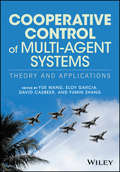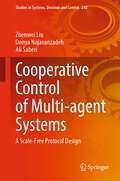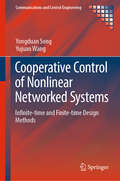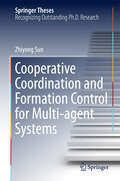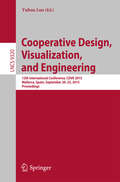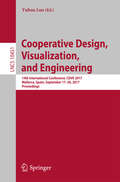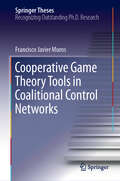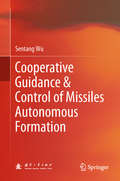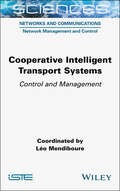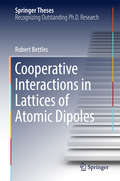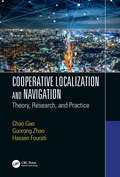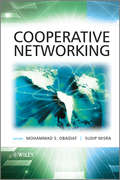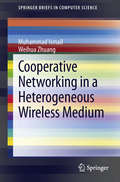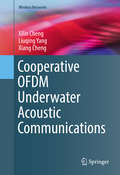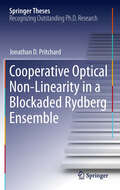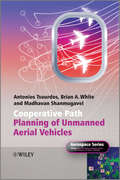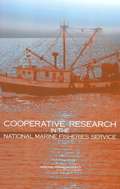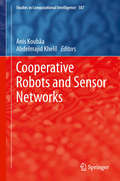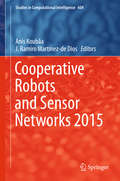- Table View
- List View
Cooperative Control of Multi-Agent Systems: Optimal and Adaptive Design Approaches (Communications and Control Engineering)
by Frank L. Lewis Abhijit Das Hongwei Zhang Kristian Hengster-MovricCooperative Control of Multi-Agent Systems extends optimal control and adaptive control design methods to multi-agent systems on communication graphs. It develops Riccati design techniques for general linear dynamics for cooperative state feedback design, cooperative observer design, and cooperative dynamic output feedback design. Both continuous-time and discrete-time dynamical multi-agent systems are treated. Optimal cooperative control is introduced and neural adaptive design techniques for multi-agent nonlinear systems with unknown dynamics, which are rarely treated in literature are developed. Results spanning systems with first-, second- and on up to general high-order nonlinear dynamics are presented. Each control methodology proposed is developed by rigorous proofs. All algorithms are justified by simulation examples. The text is self-contained and will serve as an excellent comprehensive source of information for researchers and graduate students working with multi-agent systems.
Cooperative Control of Multi-Agent Systems: Theory and Applications
by Yue Wang Eloy Garcia David Casbeer Fumin ZhangA comprehensive review of the state of the art in the control of multi-agent systems theory and applications The superiority of multi-agent systems over single agents for the control of unmanned air, water and ground vehicles has been clearly demonstrated in a wide range of application areas. Their large-scale spatial distribution, robustness, high scalability and low cost enable multi-agent systems to achieve tasks that could not successfully be performed by even the most sophisticated single agent systems. Cooperative Control of Multi-Agent Systems: Theory and Applications provides a wide-ranging review of the latest developments in the cooperative control of multi-agent systems theory and applications. The applications described are mainly in the areas of unmanned aerial vehicles (UAVs) and unmanned ground vehicles (UGVs). Throughout, the authors link basic theory to multi-agent cooperative control practice — illustrated within the context of highly-realistic scenarios of high-level missions — without losing site of the mathematical background needed to provide performance guarantees under general working conditions. Many of the problems and solutions considered involve combinations of both types of vehicles. Topics explored include target assignment, target tracking, consensus, stochastic game theory-based framework, event-triggered control, topology design and identification, coordination under uncertainty and coverage control. Establishes a bridge between fundamental cooperative control theory and specific problems of interest in a wide range of applications areas Includes example applications from the fields of space exploration, radiation shielding, site clearance, tracking/classification, surveillance, search-and-rescue and more Features detailed presentations of specific algorithms and application frameworks with relevant commercial and military applications Provides a comprehensive look at the latest developments in this rapidly evolving field, while offering informed speculation on future directions for collective control systems The use of multi-agent system technologies in both everyday commercial use and national defense is certain to increase tremendously in the years ahead, making this book a valuable resource for researchers, engineers, and applied mathematicians working in systems and controls, as well as advanced undergraduates and graduate students interested in those areas.
Cooperative Control of Multi-agent Systems: A Hybrid System Approach
by Changchun Hua Shuang Liu Guanglei Zhao Hailong CuiThis book focuses on stability analysis and control design approaches for multi-agent systems under network-induced constraints. A hybrid system approach is introduced to address the cooperative control problem of networked multi-agent systems, and several important topics such as asynchronous sampled data cooperative control, hybrid event-triggered cooperative control, and reset-based cooperative control are studied under the hybrid system framework. The special feature of this book is that a hybrid systems approach is proposed for the cooperative control of multi-agent systems, which is beneficial for relaxing the conservativeness of stability analysis and network parameter computation. Interested readers can learn a novel approach to cooperative control of multi-agent systems, and this book can benefit researchers, engineers, and graduate students in the fields of multi-robot cooperation, unmanned aerial vehicle formation, control engineering, etc.
Cooperative Control of Multi-agent Systems: A Scale-Free Protocol Design (Studies in Systems, Decision and Control #248)
by Ali Saberi Zhenwei Liu Donya NojavanzadehThis monograph represents the outcome of research effort of the authors on scalable synchronization of large-scale multi-agent systems (MAS). Cooperative control of multi-agent systems has been growing in popularity and is highly interdisciplinary in recent years. The application of synchronization of MAS includes automobile systems, aerospace systems, multiple-satellite GPS, high-resolution satellite imagery, aircraft formations, highway traffic platooning, industrial process control with multiple processes, and more. Most of the proposed protocols in the literature for synchronization of MAS require some knowledge of the communication network such as bounds on the spectrum of the associated Laplacian matrix and the number of agents. These protocols suffer from scale fragility wherein stability properties are lost for large-scale networks or when the communication graph changes. In the past few years, the authors of this monograph have worked on developing scale-free protocol design for various cases of MAS problems. The key contribution of the monograph is to offer a scale-free design framework and provide scale-free protocols to achieve synchronization, delayed synchronization, and almost synchronization in the presence of input and communication delays, input saturation and external disturbances. The scale-free design framework solely is based on the knowledge of agent models and does not depend on information about the communication network such as the spectrum of the associated Laplacian matrix or size of the network. Drawing upon their extensive work in this area, the authors provide a thorough treatment of agents with higher-order dynamics, different classes of models for agents, and the underlying networks representing actions of the agents. The high technical level of their presentation and their rigorous mathematical approach make this monograph a timely and valuable resource that will fill a gap in the existing literature.
Cooperative Control of Nonlinear Networked Systems: Infinite-time and Finite-time Design Methods (Communications and Control Engineering)
by Yongduan Song Yujuan WangCooperative Control of Nonlinear Networked Systems is concerned with the distributed cooperative control of multiple networked nonlinear systems in the presence of unknown non-parametric uncertainties and non-vanishing disturbances under certain communication conditions. It covers stability analysis tools and distributed control methods for analyzing and synthesizing nonlinear networked systems. The book presents various solutions to cooperative control problems of multiple networked nonlinear systems on graphs. The book includes various examples with segments of MATLAB® codes for readers to verify, validate, and replicate the results. The authors present a series of new control results for nonlinear networked systems subject to both non-parametric and non-vanishing uncertainties, including the cooperative uniformly ultimately bounded (CUUB) result, finite-time stability result, and finite-time cooperative uniformly ultimately bounded (FT-CUUB) result. With some mathematical tools, such as algebraic graph theory and certain aspects of matrix analysis theory introduced by the authors, the readers can obtain a deeper understanding of the roles of matrix operators as mathematical machinery for cooperative control design for multi-agent systems. Cooperative Control of Nonlinear Networked Systems is a valuable source of information for researchers and engineers in cooperative adaptive control, as its technical contents are presented with examples in full analytical and numerical detail, and graphically illustrated for easy-to-understand results. Scientists in research institutes and academics in universities working on nonlinear systems, adaptive control and distributed control will find the book of interest, as it contains multi-disciplinary problems and covers different areas of research.
Cooperative Coordination and Formation Control for Multi-agent Systems (Springer Theses)
by Zhiyong SunThe thesis presents new results on multi-agent formation control, focusing on the distributed stabilization control of rigid formation shapes. It analyzes a range of current research problems such as problems concerning the equilibrium and stability of formation control systems, or the problem of cooperative coordination control when agents have general dynamical models, and discusses practical considerations arising during the implementation of established formation control algorithms. In addition, the thesis presents models of increasing complexity, from single integrator models, to double integrator models, to agents modeled by nonlinear kinematic and dynamic equations, including the familiar unicycle model and nonlinear system equations with drift terms. Presenting the fruits of a close collaboration between several top control groups at leading universities including Yale University, Groningen University, Purdue University and Gwangju Institute of Science and Technology (GIST), the thesis spans various research areas, including robustness issues in formations, quantization-based coordination, exponential stability in formation systems, and cooperative coordination of networked heterogeneous systems.
Cooperative Coverage Control of Multi-Agent Systems and its Applications (Studies in Systems, Decision and Control #408)
by Gaoxi Xiao Chao Zhai Hai-Tao ZhangThis book highlights cooperative coverage control approaches of multi-agent systems in uncertain environments and their applications in various fields. A novel theoretical formulation of multi-agent coverage is proposed to fulfill the coverage task via divide-and-conquer scheme. By taking workload partition and sweeping operations simultaneously, a distributed sweep coverage algorithm of multi-agent systems is developed to cooperatively complete the workload on the given region, and its input-to-state stability is guaranteed in theory. Moreover, the coverage performance is evaluated by estimating the error between the actual coverage time and the optimal time. Three application scenarios are presented to demonstrate the advantages of cooperative coverage control approaches in missile interception, intelligent transportation systems and environment monitoring, respectively.
Cooperative Design, Visualization, and Engineering: 12th International Conference, CDVE 2015, Mallorca, Spain, September 20-23, 2015. Proceedings (Lecture Notes in Computer Science #9320)
by Yuhua LuoThis book constitutes the refereed proceedings of the 12th International Conference on Cooperative Design, Visualization, and Engineering, CDVE 2015, held in Mallorca, Spain, in September 2015. The 30 full papers presented together with 4 short papers were carefully reviewed and selected from numerous submissions. There is a group of papers dressing the big data related to the cooperative work. It includes the information modeling, intensive task management, how to use the cloud technology to foster the cooperation etc. To deal with the social network issues is the topic of another group of papers in this volume. They range from creating programming languages to automate cooperative processes, social network information visualization, and the ranking cooperative research teams by analyzing the social network data.
Cooperative Design, Visualization, and Engineering: 14th International Conference, CDVE 2017, Mallorca, Spain, September 17-20, 2017, Proceedings (Lecture Notes in Computer Science #10451)
by Yuhua LuoThis book constitutes the refereed proceedings of the 4th International Conference on Cooperative Design, Visualization, and Engineering, CDVE 2007, held in Shanghai, China in September 2007. The papers presented were carefully reviewed from numerous submissions. The papers cover all current issues in cooperative design, visualization, and engineering, ranging from theoretical and methodological topics to various systems and frameworks to applications in a variety of fields.
Cooperative Device-to-Device Communication in Cognitive Radio Cellular Networks (SpringerBriefs in Computer Science)
by Peng Li Song GuoThis brief examines current research on cooperative device-to-device (D2D) communication as an enhanced offloading technology to improve the performance of cognitive radio cellular networks. By providing an extensive review of recent advances in D2D communication, the authors demonstrate that the quality of D2D links significantly affects offloading performance in cellular networks, which motivates the design of cooperative D2D communication. After presenting the architecture of cooperative D2D communication, the challenges of capacity maximization and energy efficiency are addressed by optimizing relay assignment, power control and resource allocation. Furthermore, cooperative D2D communication is enhanced by network coding technology, and then is extended for broadcast sessions. Along with detailed problem formulation and hardness analysis, fast algorithms are developed by exploiting problem-specific characteristics such that they can be applied in practice.
Cooperative Game Theory Tools in Coalitional Control Networks (Springer Theses)
by Francisco Javier MurosThis book analyzes coalitional control schemes by incorporating concepts of cooperative game theory into a distributed control framework. It considers a networked architecture where the nodes are the agents and the edges are their communication links and either the agents or the links are established as the players of cooperative games related to the cost function of the coalitional schemes. The book discusses various cooperative game theory tools that are used to measure/analyze the players’ features, impose constraints on them, provide alternative methods of game computation, detect critical players inside the control scheme, and perform system partitioning of large-scale systems, such as the Barcelona drinking water network, which is described in a case study.
Cooperative Guidance & Control of Missiles Autonomous Formation
by Sentang WuThis book primarily illustrates the rationale, design and technical realization/verification for the cooperative guidance and control systems (CGCSs) of missile autonomous formation (MAF). From the seven functions to the five major compositions of CGCS, the book systematically explains the theory and modeling, analysis, synthesis and design of CGCSs for MAF, including bionics-based theories.Further, the book addresses how to create corresponding digital simulation analysis systems, as well as hardware in the loop (HIL) simulation test systems and flight test systems, to evaluate the combat effectiveness of MAF. Lastly, it provides detailed information on digital simulation analysis for a large range of wind tunnel test data, as well as test results of HIL system simulations and embedded systems testing.
Cooperative Intelligent Transport Systems: Control and Management (ISTE Consignment)
by Léo MendiboureThe advent of the automated and connected vehicle will require the implementation of high-performance communication systems: Cooperative Intelligent Transport Systems (C-ITS). However, controlling and managing these C-ITS is complex. A number of points need to be jointly considered: 1) a high level of performance to guarantee the Quality of Service requirements of vehicular applications (latency, bandwidth, etc.); 2) a sufficient level of security to guarantee the correct operation of applications; and 3) the implementation of an architecture that guarantees interoperability between different communication systems. In response to these issues, this book presents new solutions for the management and control of Intelligent and Cooperative Transport Systems. The proposed solutions have different objectives, ranging from increased safety to higher levels of performance and the implementation of new, more energyefficient mechanisms.
Cooperative Interactions in Lattices of Atomic Dipoles (Springer Theses)
by Robert BettlesThis thesis reports the remarkable discovery that, by arranging the dipoles in an ordered array with particular spacings, it is possible to greatly enhance the cross-section and achieve a strong light-matter coupling (>98% of the incident light). It also discusses the broad background to cooperative behaviour in atomic ensembles, and analyses in detail effects in one- and two-dimensional atomic arrays. In general, when light interacts with matter it excites electric dipoles and since the nineteenth century it has been known that if the amplitude of these induced dipoles is sufficiently large, and their distance apart is on the scale of the wavelength of the light, then their mutual interaction significantly modifies the light-matter interaction. However, it was not known how to exploit this effect to modify the light-matter interaction in a desirable way, for example in order to enhance the optical cross-section.
Cooperative Localization and Navigation: Theory, Research, and Practice
by Chao Gao Hassen Fourati Guorong ZhaoThis book captures the latest results and techniques for cooperative localization and navigation drawn from a broad array of disciplines. It provides the reader with a generic and comprehensive view of modeling, strategies, and state estimation methodologies in that fields. It discusses the most recent research and novel advances in that direction, exploring the design of algorithms and architectures, benefits, and challenging aspects, as well as a potential broad array of disciplines, including wireless communication, indoor localization, robotics, emergency rescue, motion analysis, etc.
Cooperative Networking
by Sudip Misra Mohammad S. ObaidatThis book focuses on the latest trends and research results in Cooperative NetworkingThis book discusses the issues involved in cooperative networking, namely, bottleneck resource management, resource utilization, servers and content, security, and so on. In addition, the authors address instances of cooperation in nature which actively encourage the development of cooperation in telecommunication networks. Following an introduction to the fundamentals and issues surrounding cooperative networking, the book addresses models of cooperation, inspirations of successful cooperation from nature and society, cooperation in networking (for e.g. Peer-to-Peer, wireless ad-hoc and sensor, client-server, and autonomous vehicular networks), cooperation and ambient networking, cooperative caching, cooperative networking for streaming media content, optimal node-task allocation, heterogeneity issues in cooperative networking, cooperative search in networks, and security and privacy issues with cooperative networking.It contains contributions from high profile researchers and is edited by leading experts in this field.Key Features:Focuses on higher layer networkingAddresses the latest trends and research results Covers fundamental concepts, models, advanced topics and performance issues in cooperative networkingContains contributions from leading experts in the fieldProvides an insight into the future direction of cooperative networkingIncludes an accompanying website containing PowerPoint slides and a glossary of terms (www.wiley.com/go/obaidat_cooperative)This book is an ideal reference for researchers and practitioners working in the field. It will also serve as an excellent textbook for graduate and senior undergraduate courses in computer science, computer engineering, electrical engineering, software engineering, and information engineering and science.
Cooperative Networking in a Heterogeneous Wireless Medium (SpringerBriefs in Computer Science)
by Weihua Zhuang Muhammad IsmailThis brief focuses on radio resource allocation in a heterogeneous wireless medium. It presents radio resource allocation algorithms with decentralized implementation, which support both single-network and multi-homing services. The brief provides a set of cooperative networking algorithms, which rely on the concepts of short-term call traffic load prediction, network cooperation, convex optimization, and decomposition theory. In the proposed solutions, mobile terminals play an active role in the resource allocation operation, instead of their traditional role as passive service recipients in the networking environment.
Cooperative OFDM Underwater Acoustic Communications (Wireless Networks)
by Xilin Cheng Liuqing Yang Xiang ChengFollowing underwater acoustic channel modeling, this book investigates the relationship between coherence time and transmission distances. It considers the power allocation issues of two typical transmission scenarios, namely short-range transmission and medium-long range transmission. For the former scenario, an adaptive system is developed based on instantaneous channel state information. The primary focus is on cooperative dual-hop orthogonal frequency division multiplexing (OFDM). This book includes the decomposed fountain codes designed to enable reliable communications with higher energy efficiency. It covers the Doppler Effect, which improves packet transmission reliability for effective low-complexity mirror-mapping-based intercarrier interference cancellation schemes capable of suppressing the intercarrier interference power level. Designed for professionals and researchers in the field of underwater acoustic communications, this book is also suitable for advanced-level students in electrical engineering or computer science.
Cooperative Optical Non-Linearity in a Blockaded Rydberg Ensemble (Springer Theses)
by Jonathan D. PritchardThis thesis describes the first demonstration of a cooperative optical non-linearity based on Rydberg excitation. Whereas in conventional non-linear optics the non-linearity arises directly from the interaction between light and matter, in a cooperative process it is mediated by dipole-dipole interactions between light-induced excitations. For excitation to high Rydberg states where the electron is only weakly bound, the dipole-dipole interactions are extremely large and long range, enabling an enormous enhancement of the non-linear effect. Consequently, cooperative non-linear optics using Rydberg excitations opens a new era for quantum optics enabling large single photon non-linearity to be accessible in free space for the first time. The thesis describes the theoretical underpinnings of the non- linear effect, the pioneering experimental results and implications for experiments in the single photon regime.
Cooperative Optimal Control of Hybrid Energy Systems
by Dong Yue Huifeng Zhang Chunxia DouThis book mainly investigates the cooperative optimal control of hybrid energy system, it presents security control, multi-objective optimization, distributed optimization and distributed control approaches for tackling with security, economic and stability problem of the hybrid energy system.It aims to solve some challenging problems including security issue, economic cost or benefits from both power generation side and load demand side, and coordination among different power generators. The methods proposed in this book is novel and attractive, it consists of the hierarchical optimal control strategy for the security issue, multi-objective optimization for both economic and emission issue, and distributed optimal control for coordination among power generators.Readers can learn novel methods or technique for tackling with the security issue, multiple-objective problem, and distributed coordination problem. It also may inspire readers to improve some drawbacks of existing alternatives.Some fundamental knowledge prepared to read this book includes basic principles of the multi-agents system, robust optimization, Pareto-dominance optimization, and background of electrical engineering and renewable energy.
Cooperative Path Planning of Unmanned Aerial Vehicles (Aerospace Series #32)
by Antonios Tsourdos Brian White Madhavan ShanmugavelAn invaluable addition to the literature on UAV guidance and cooperative control, Cooperative Path Planning of Unmanned Aerial Vehicles is a dedicated, practical guide to computational path planning for UAVs. One of the key issues facing future development of UAVs is path planning: it is vital that swarm UAVs/ MAVs can cooperate together in a coordinated manner, obeying a pre-planned course but able to react to their environment by communicating and cooperating. An optimized path is necessary in order to ensure a UAV completes its mission efficiently, safely, and successfully. Focussing on the path planning of multiple UAVs for simultaneous arrival on target, Cooperative Path Planning of Unmanned Aerial Vehicles also offers coverage of path planners that are applicable to land, sea, or space-borne vehicles. Cooperative Path Planning of Unmanned Aerial Vehicles is authored by leading researchers from Cranfield University and provides an authoritative resource for researchers, academics and engineers working in the area of cooperative systems, cooperative control and optimization particularly in the aerospace industry.
Cooperative Radio Communications for Green Smart Environments
by Narcis CardonaThe demand for mobile connectivity is continuously increasing, and by 2020 Mobile and Wireless Communications will serve not only very dense populations of mobile phones and nomadic computers, but also the expected multiplicity of devices and sensors located in machines, vehicles, health systems and city infrastructures. Future Mobile Networks are then faced with many new scenarios and use cases, which will load the networks with different data traffic patterns, in new or shared spectrum bands, creating new specific requirements. This book addresses both the techniques to model, analyse and optimise the radio links and transmission systems in such scenarios, together with the most advanced radio access, resource management and mobile networking technologies. This text summarises the work performed by more than 500 researchers from more than 120 institutions in Europe, America and Asia, from both academia and industries, within the framework of the COST IC1004 Action on "Cooperative Radio Communications for Green and Smart Environments". The book will have appeal to graduates and researchers in the Radio Communications area, and also to engineers working in the Wireless industry. Topics discussed in this book include: • Radio waves propagation phenomena in diverse urban, indoor, vehicular and body environments• Measurements, characterization, and modelling of radio channels beyond 4G networks• Key issues in Vehicle (V2X) communication• Wireless Body Area Networks, including specific Radio Channel Models for WBANs• Energy efficiency and resource management enhancements in Radio Access Networks• Definitions and models for the virtualised and cloud RAN architectures• Advances on feasible indoor localization and tracking techniques• Recent findings and innovations in antenna systems for communications• Physical Layer Network Coding for next generation wireless systems• Methods and techniques for MIMO Over the Air (OTA) testing
Cooperative Research In The National Marine Fisheries Service
by Committee on Cooperative Research in the National Marine Fisheries ServiceIn recent years there has been growing interest in having fisheries stakeholders involved in various aspects of fisheries data collection and experimentation. This activity is generally known as cooperative research and may take many forms, including gear technology studies, bycatch avoidance studies, and surveys. While the process is not new, the current interest in cooperative research and the growing frequency of direct budgetary allocation for cooperative research prompted this report. Cooperative Research in the National Marine Fisheries Serviceaddresses issues essential for the effective design and implementation of cooperative and collaborative research programs.
Cooperative Robots and Sensor Networks (Studies in Computational Intelligence #507)
by Anis Koubâa Abdelmajid KhelilMobile robots and Wireless Sensor Networks (WSNs) have enabled great potentials and a large space for ubiquitous and pervasive applications. Robotics and WSNs have mostly been considered as separate research fields and little work has investigated the marriage between these two technologies. However, these two technologies share several features, enable common cyber-physical applications and provide complementary support to each other. The primary objective of book is to provide a reference for cutting-edge studies and research trends pertaining to robotics and sensor networks, and in particular for the coupling between them. The book consists of five chapters. The first chapter presents a cooperation strategy for teams of multiple autonomous vehicles to solve the rendezvous problem. The second chapter is motivated by the need to improve existing solutions that deal with connectivity prediction, and proposed a genetic machine learning approach for link-quality prediction. The third chapter presents an architecture for indoor navigation using an Android smartphone for guiding a variety of users, from sighted to the visually impaired, to their intended destination. In chapter four, the authors deal with accurate prediction modeling of ocean currents for underwater glider navigation. In chapter five, the authors discuss the challenges and limitations of RSS-based localization mechanisms and propose, EasyLoc, an autonomous and practical RSS-based localization technique that satisfies ease of deployment and implementation.
Cooperative Robots and Sensor Networks 2015 (Studies in Computational Intelligence #604)
by Anis Koubâa J.Ramiro Martínez-de DiosThis book compiles some of the latest research in cooperation between robots and sensor networks. Structured in twelve chapters, this book addresses fundamental, theoretical, implementation and experimentation issues. The chapters are organized into four parts namely multi-robots systems, data fusion and localization, security and dependability, and mobility.

